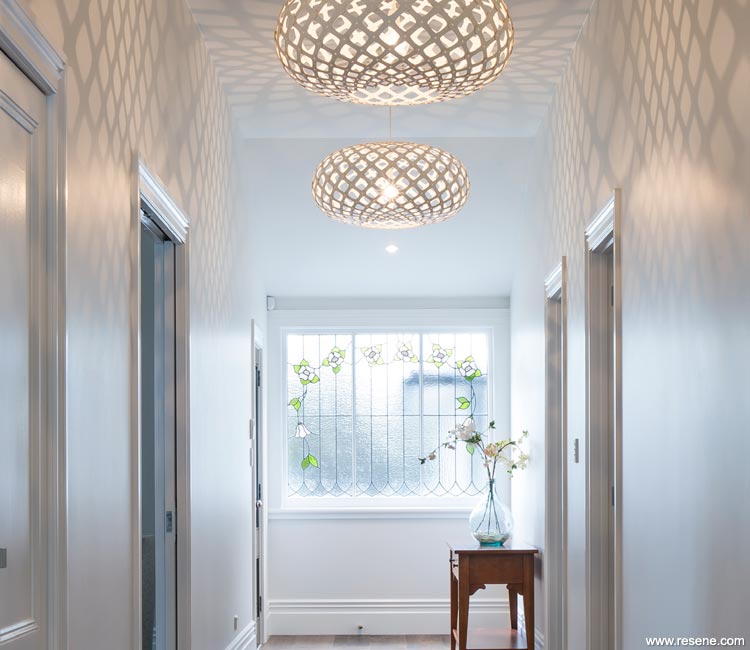You’ve been to your local Resene ColorShop and chosen the perfect soft white for your living room. You get home, turn on the lights and... that white paint chip now looks dingy. What happened? It’s all about the lights. How colours appear can depend on the type of artificial light you have.
Those at the store are probably fluorescent, and therefore give a clean, bright light. Or the store might have south-facing windows that bring in a cool light. At home, your incandescent bulbs may throw a much warmer cast.
Likewise, your elegantly cool white walls might turn dull and shadowy. Or your creamy walls might gain a distinctly orange hue in the evening.
Incandescent light bulbs are the mostly commonly found in our houses. They emit a warm, yellow light similar to that of candlelight so will make warm whites and other warm colours more vivid, but if a low wattage is used, it will mute cool whites and colours. They cast a brighter area of light close to the bulb so can leave corners of the room in shadow.
LED bulbs are a great energy-efficient lighting and are being increasingly used in new homes and renovations. They are available in both cool and warm white light. Look for lights with a 90-plus colour rendering index to get a truer result.
Halogen bulbs impart a bright, sparkling white colour that resembles natural light the most closely. They become very hot when used for prolonged periods, and are more expensive than both incandescent and LED in the long run.
Fluorescent lights are the opposite of incandescent, giving off a cool, blue light. This is similar to natural light from the south. ‘Warm’ fluorescent bulbs are also available.
Of course, it’s not all about the type of bulb but about where you put them. The right combination of lights and light sources (pendants, floor lamps, recessed etc), can make or break your interior scheme. There’s general or ambiant light, task lighting for specific areas, and accent lighting for added drama – like an uplight on a wall, or a standard lamp throwing a pool of light.
As a general rule, we need less light in living rooms, dining areas and bedrooms because we want greater ambiance – although if you regularly read books, magazine or newspapers in these areas, make sure there is a good lamp beside your chair. Kitchens need good bright, even light so that we can safely prepare and cook our food. And clean up afterwards. Bathrooms and studies also need good bright general lighting and good task lighting.
 Resene Sea Fog hallway by Trinity Interior Design.
Resene Sea Fog hallway by Trinity Interior Design.
Most of us will have experienced the scenario of taking a pair of apparently black socks out of the drawer, then realising later that one of them is blue. It doesn’t mean you’re colour blind – it’s a common phenomenon called sample metamerism.
Incandescent light bulbs emit very few short blue wavelengths, which makes it hard to differentiate between dark blue and black. Fluorescent light emits more short-wavelength light, so it’s easier to distinguish the two colours. When two identical colour samples look vastly different when viewed under different lights, it’s called illuminant metamerism.
Then there’s observer metamerism – the fact that individuals perceive colour slightly differently. Another is geometric metamerism – the different appearance of colours when seen from different angles, distances and light positions. One reason why men and women often see colour differently is that the distance between a woman’s eyes is usually slightly less than a man’s.
Metamerism also affects the way we view paint charts, which is why Resene uses actual Resene paint on colour charts, to give you a more accurate colour sample than ink can.
The amount of colour can also affect the way we see it. The more of a colour there is, usually the more intense it will seem. It will also be influenced by adjacent colours, so if you paint your sample direct onto a green wall, you can expect the offwhite to pick up the green and look decidedly green.
Wherever possible, it is best to develop a lighting plan at the same time as your paint scheme. For example, if you decide to paint any of the rooms in a dark colour, you are likely to need more lighting than if your walls were pale and would therefore reflect the light. If you are moving from a very dark colour scheme to a light and bright one, you may need to reduce the lighting or the light bulb strength to avoid it being too glary.
Search Habitat articles
If you have an idea, project or story that you think would suit Habitat plus, we’d love to hear from you. Please drop us an email with your details and include photos if submitting a project.
Habitat plus are not mailed directly. They are available free from Resene ColorShops and resellers while stocks last and available for viewing online.